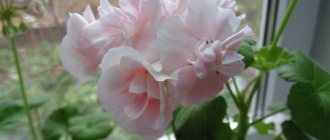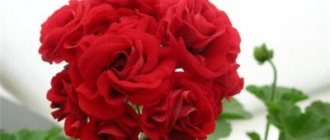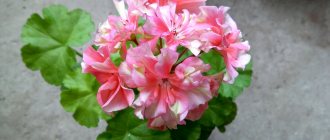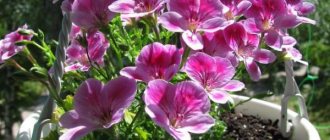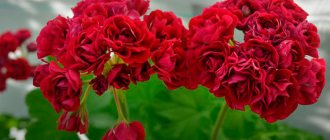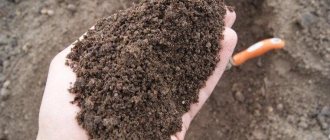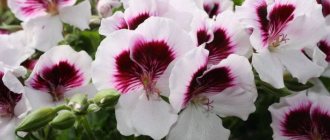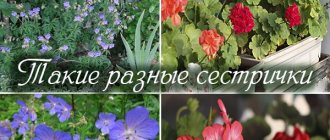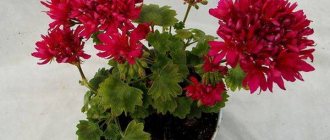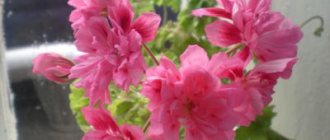Pelargonium Elnaryds Hilda and other varieties of the Elnaruds series
Geranium is one of the most beloved home plants by gardeners. There are many varieties of this culture. Pelargonium Elnaryds Hilda stands out among all. Thanks to its short stature, lush bushes and abundant flowering, it quickly gained popularity among lovers of home flowers.
The history of the appearance of the pelargonium variety Elnarids
Pelargonium was first discovered in the wild in Africa and southern Asia. Then it quickly spread across all continents, and came to Europe in the 17th century. Later, thanks to the efforts of breeders, different types of flowers were bred. Many of them began to be grown as ornamental plants.
This is interesting! Pelargonium and geranium are often confused. You can distinguish them by their bud. Geranium has 5 identical petals. Pelargonium has 2 upper and 3 lower ones, differing from each other in size and shape.
Description of varieties
Among the varieties of pelargonium of the Elnaruds series, there are the most common ones.
Hilda
Compact pelargonium with lush double buds of uneven pink and white color. The leaves are yellow with a brown spot in the middle. Hilda tolerates heat well and has a long flowering period.
Gusten
A vigorously flowering variety of pelargonium Elnaryds. The inflorescences are dense, the buds are peachy-pink. The bush has a compact shape.
Bente
Zonal pelargonium. It reaches a height of 10 cm. The inflorescences are lush and double. The buds are apricot-red. Flowering of this species begins in May and continues until the end of September.
Bente flower
Otto is often used to decorate balconies and verandas. The buds of this variety are orange in color, gradually turning into soft pink. The bush reaches a height of 10 cm. Flowering begins in late spring.
A variety of flower called Otto
Singoalla
House plant with white, slightly pinkish flowers. The bush is compact and easy to shape.
Lilian
A dwarf plant with double voluminous inflorescences. The buds can be bluish-lavender in spring and pink in summer.
Representative of the Lilian variety
Clarissa
Lush bush with snow-white double flowers. The plant is compact and does not require formation.
Clarissa flower
Landing
Most varieties of pelargonium are dwarf plants, so they need a small pot. In this case, the flower will give all its strength to the growth of shoots, not roots. The soil should be selected so that it contains some sand and peat.
Reproduction
Pelargonium reproduces by seeds. They are planted in boxes with peat and left in a room with an air temperature of no more than +20 °C. The first shoots should appear in 3 weeks. All this time, the seedlings need to be irrigated with water from a spray bottle.
Important! The sprouts are moved to separate pots in early May. They need to be buried 4 cm into the ground and watered.
Basic flower care procedures:
- After planting in the ground, the plant needs to be watered several times a week. Do not over-water the soil or allow it to dry out.
- During the growing season, the flower must be fed with fertilizers containing nitrogen, potassium and phosphorus. However, you should not do this more than twice a month.
- Many types of pelargonium require formative pruning. To do this, the leaves are pinched so that the bush grows wider.
- In summer, the flower can be taken out into the fresh air and placed in places protected from direct sunlight.
- In winter, it is better to keep the plant in a place with a temperature of at least +20 °C. At this time, you need to water it no more than twice a month.
- It is recommended to replant pelargonium once every three years. The procedure must be performed in April or March so that the flower has time to take root by June and begin to bloom.
Diseases and pests
Pelargonium has high immunity, so pests and diseases rarely bother it. But if not properly cared for, problems can still arise.
Blooming Pelargonium Hilda
If the plant is in the wrong place or has an incorrect watering schedule, this is indicated by the following signs:
- lack of flowering;
- rusty or dried leaves;
- rotting of the root system.
It is necessary to immediately eliminate the cause of the disease and treat the plant with fungicides.
In some cases, aphids, mealybugs or whiteflies may appear on the bush. When they are detected, the flower is sprayed with insecticides.
With proper care, pelargonium will become an excellent ornamental plant with bright, unusual flowers.
Diseases and pests, combating them
Common diseases:
- Gray rot. For treatment, the bush is transplanted into new soil, the damaged parts of the roots are cut off before this. The sections are treated with a solution of potassium permanganate.
- Verticillium wilt can be stopped by treating the bush with Fundazol or Vitaros.
- It is best to remove aphids by spraying with a solution of regular soap.
- Treatment with acaricidal preparations saves the bush from spider mites.
Important! In order to avoid having to deal with pests and diseases, you need to carefully care for the flower.
Pelargonium is a beautiful and unpretentious plant, which can be called one of the favorites of most gardeners.
Elnaryds hilda pelargonium
List of availability of pelargoniums as of 02/14/2021
- Alex Kitson 250
- Alice 250
- Alison March 500
- Ambrose 250
- Ansbrook Mulberry Blotch 750
- April Snow 300
- Asarnas Oden 300
- Barbara Hines 250
- Big Eeze Foxy Flamingo 200
- Bob Newing 800
- Bold Ann 350
- Bold Beacon 250
- Bold Carmine 300
- Bold Cherub 300
- Bold Cloud 300
- Bold Diamond Wedding 450
- Bold Elf (Fibrex) 500
- Bold Festival 350
- Bold Flame 250
- Bold Gold 300
- Bold Joy 300
- Bold Limelight 300
- Bold Magic 300
- Bold Minstrel 350
- Bold Parade 350
- Bold Pixie 300
- Bold Princess 250
- Bold Romance 400
- Bold Rose 300
- Bold Sunrise 300
- Boniface Butterfly 250
- Bornholmpelargon 300
- Brightstone 250
- Brittens Rara 250
- Brixworth Pearl 400
- Brocade Cherry Night 250
- Brocade Salmon Night 250
- Brocade Fire Night 200
- Brookside Betty 300
- Brookside Fantasy 400
- Brookside Flamenco 300
- Brookside Miranda 500
- Brookside Petya 500
- Brookside Rosa 350
- Burns Country 200
- Calliope Dark Red 250
- Cheiko 300
- Chelsea Gem 500
- Chelsea Star 500
- Cherry Cocktail 1000
- Clatterford 300
- Conny 400
- Contrast 250
- Courtney Watson 450
- Deacon Golden Lilac Mist 250
- Deacon Trousseau 200
- Denise Sutarve 400
- Dovepoint 250
- Dream Lover 300
- Dylan Sherone 200
- Edwards Blanche 300
- Edwards Courtney 300
- Edwards Elegance 300
- Edwards Green Eyes 300
- Edwards Pleasure 350
- Edwards Tamara 400
- Edwards Toscana 300
- Edwin fran Vinjian 300
- Elnaryds Hilda 350
- Elnaryds Rasken 350
- Fir Trees Silver Wedding 500
- Francis Parrett 350
- Fee Cerise Polina 350
- Gardenia 300
- Godshill 250
- Golden Brilliantissimum 700
- Golden Choice 250
- Grainger's Antique Rose 500
- Granny Barter 250
- Happy Appleblossom Rosebud 300
- Highfield's Ballerina (Fibrex) 400
- Highfield's Sugar Candy 300
- Highfield's Charisma 300
- Honeywood Suzanne 300
- Hope JP Bartlett 600
- Hope Valley 250
- Jip's Betty Thomas 300
- Jip's Bunjy 700
- Jip's Freda Burges 350
- Jip's John Morbey 800
- Jip's Megan 350
- Jip's Pip 250
- June Patricia 300
- Just Bella 250
- Jagershus Mormor Marta 300
- Jagershus Roda Rudolf 250
- Kelly Brougham 300
- Kenny's Double 500
- Kitbridge 300
- Lara Dora Price 700
- Lara Envoy 700
- Lara Harmony 350
- Lara Mandarin 1500
- Lara Marjorie 1500
- Lara Rita 700
- Lilian Andrea 450
- Linnea Andrea 500
- Little Glitter 300
- Little Jim 400
- Little Jip 800
- Lolette 450
- Lotta Lundberg 300
- Marbacka Tulpan 450
- Marie Louise 450
- Martha Parmer 200
- Meadowside Fancy 200
- Michelle West 300
- Midori Buke 1500
- Minah's Cascade 350
- Mini Czech 300
- Mini Diane 350
- Minnie 200
- Mrs. Charles 500
- Mrs. May Last 800
- Mrs. Pollock 250
- Noel Gordon 300
- Norrangens Sofia 350
- Norrland 300
- Norrland Sport Red 400
- Occold Lagoon 200
- Odensjo Black Mamba 450
- Odensjo Hummingbirds Egg Butterfly 250
- Odensjo Kimberly 250
- Odensjo Ljus och Varme 250
- Odensjo Madame Bovary 350
- Odensjo Tango 500
- Odensjo Tintomara 400
- Odensjo Whiskey and Wine 300
- Oliver Welfare 700
- Orange Glitter 250
- Orangesonne 250
- Madperal Rose 1500
- PAC Chocolate Pink 200
- PAC Emilia 250
- PAC Fireworks Bicolor 200
- PAC Flower Fairy Velvet 200
- PAC Happy Birthday 600
- PAC Salmon Comtesse 300
- PAC Salmon Queen 250
- PAC TwoInOne White 200
- PAC Viva Madeleine 400
- PAC Viva Rosita 400
- Passat 250
- Persian Ruler 500
- Pink Needles 400
- Pink Pandora 600
- Pink Rambler 300
- Pink Splash 250
- Potter Heigham 250
- Powder Puff 250
- Prince Gustav 1500
- Princess Sandra 300
- Princess Filippa 700
- Princess Filippa 600
- Princess Marie 300
- Priory Star 300
- Priory Coral 1000
- Queen Ingrid 200
- Ray Bidwell 700
- Red Pandora 300
- Rookley 250
- Rushmoor Bondi Blue 300
- Rushmoor Orinoco 1500
- Saga 400
- Samantha Stamp 250
- Santa Maria Centennial 250
- Sarita Wild Salmon 200
- Saxdalens Selma 300
- Selecta Moonlight Violino 250
- Shelk Moira 600
- Silver Candy 800
- Silver Delight 450
- Silver Shadow 700
- Sister Henry 250
- Sophie Emma 300
- Sophie Marion 200
- Spitfire 500
- Stan Rawlings 1000
- Star Flair 300
- Stolen Kisses 250
- Sunborn 250
- Survivor Idols Rosalinda 250
- Sutarves Clara San 300
- Sutarves Nada K 300
- Swainham Spring 250
- Tara Caws 250
- Trumphs 250
- Twodees 300
- Vancouver Centennial 250
- Vectis Finery 250
- Vic Caws 350
- Vina 250
- Warrain 250
- Warrenorth Emerald 800
- Warrenorth Pearl 500
- Wedding Royale 350
- Westdale Appleblossom 700
- Wilhelm Langguth 200
- ElKa Augustchanka 300
- IV - Krasnaya Moskva 600
- IV – Maslenitsa 400
- IV - Sonya Nezhnaya 400
- IV – Czardas 400
- Irida FOR Luxury 2000
- Irida FOR Luxury 1500
- Pink Pearl 400
- Silk Laguna 350
- Silk Moira 600
- Silk Elegy 350
- Silk Yablonka 300
- Yu_Gamayun 1000
- Yu_Wild Rose 600
- Yu_Sakura 1500
- SOUTH — Varvara Krasa 500
- SOUTH - Gulsheker 600
- SOUTH - Ireland 400
- SOUTH - Kadriya 500
- SOUTH - Nina 700
- SOUTH - Princess Grace 1500
- SOUTH – Safura 450
- Royal Black Rose 250
- PAC Lillac Rose 250
- Ice Rose 250
- Quantock Double Diamond 500
- Quantock May 250
- Brilliantine 200
- Charity 250
- Clorinda 200
- Concolor Lace 150
- Lady Plymouth 250
- Mabel Gray 250
- P. denticulatum 200
- p. fragrans 200
- Orange Fizz 200
- Phyllis 500
List of the most popular hashtags for theme #PELARGONIVARIETIES
9 popular posts with hashtag #PELARGONIVARIETIES on instagram
Today I started cutting pelargoniums. #pelargoniums #varietal pelargoniums #flowers at home #pelargonium #geraniumblooms #pelargonia #pelargonium
Terry zonal pelargonium Elnaryds Hilda with pink flowers in tight, dense caps. It blooms profusely and continuously from May. The bush is small, compact and fluffy. The leaves are golden with a bright brown zone - the highlight of the variety! #pelargoniums #varietal pelargoniums #flowers at home #pelargonium #geraniumblooms #pelargonia #pelargonium #varietalpelargoniums #pelargoniumsblooming #pelargoniummoscow #pelargonium cuttings #varietal geranium #geranium #eagle #oka #city of the first salute
Variegated pelargonium warrenorth coral, very beautiful leaf color and coral flowers argoniiivniissok #pelargoniumkaluga
There was a request to show how I remove old leaves when a sprout appeared in the axil of the leaf.
Pelargonium "Francis Parrett" Delicate and compact girl, flowery and beautiful at any age. #pelargoniums_varieties_lyudmila
Terry zonal pelargonium of German selection with the code name Coral. #pelargoniums #varietal pelargoniums #flowers at home #pelargonium #geraniumblooms #pelargonia #pelargonium
Another variegated variety with elegant foliage warrenorth gold #pelargonium #pelargonia #geranium #geranium #geraniumblooms #geraniumvarietal #pelargonium #pelargoniums #zonal pelargonium #varietal pelargonium #pelargoniumvarietal #flowersonbalcony #flowersonwindowsill #indoorflowers #indoorplants #pelargoniumsingle #pelargoniumivniissok #sang argoniakaluga
The Aina variety is a win-win option for zonal pelargonium. Grows well, can be shaped, can be either a standard or a compact plant. The caps are dense, densely terry, bright crimson-red. When they fade, they do not fall off, but dry up in the inflorescence. Unpretentious, winters well, cuttings take root easily. An excellent option for beginner gardeners. #pelargoniums_varieties_lyudmila
Methods for propagating a flower, when is it best to do it
Pelargonium is recommended to be propagated by cuttings. This method helps maintain hybrid characteristics. Sometimes the seed method is also used. Most often it is used for selection.
Reproduction by cuttings
After pruning the bushes, there are usually a lot of branches left. To propagate the crop, the strongest and healthiest shoots that can be rooted are selected. The lower leaves must be removed from them.
Then the planting material is placed in water or substrate. It is permissible to add a growth stimulator to the water - Kornevin or a similar drug. When planting in the ground, deepen the branch by 3 cm and carefully water it. Cover the plant with a glass jar on top. The appearance of new leaves on the cuttings indicates its rooting.
Propagation by seeds
A more complex method of propagating pelargonium. It is recommended to harvest planting material after flowering has completed, when the flower stalks are replaced by seed pods.
They are torn off and the seeds are carefully poured out. Then soak for a day in a pale solution of potassium permanganate
This will help activate growth processes.
Then the seeds are placed in geranium soil and covered with a bag or glass. By creating a greenhouse, it is possible to stimulate the appearance of sprouts. When the sprouts grow to 3-4 cm, they are planted in new containers.
Important! The collected seed material is stored in a cool place for 5 years. They are in no hurry to plant it in the ground
Pelargonium Elnaryds Hilda dan lain-lain jenis siri Elnaruds
Geranium adalah salah satu penanam rumah yang paling disayangi oleh penanam bunga. Terdapat banyak jenis budaya ini. Pelargonium Elnaryds Hilda menonjol di antara semua. Oleh kerana pertumbuhannya yang rendah, semak-semak subur dan berbunga yang banyak, ia dengan cepat mendapat populariti di kalangan pencinta bunga rumah.
Sejarah penampilan pelbagai pelargonium Elnarids
Untuk kali pertama di alam liar, pelargonium ditemui di Afrika dan Asia Selatan. Kemudian ia cepat merebak ke seluruh benua, dan datang ke Eropah pada abad ke-17. Di masa depan, terima kasih kepada usaha penternak, pelbagai jenis bunga dibiakkan. Kebanyakan mereka mula ditanam sebagai tumbuhan hiasan.
Ini menarik! Pelargonium dan geranium sering keliru. Anda boleh membezakannya dengan tunas. Geranium mempunyai 5 kelopak yang sama. Pelargonium mempunyai 2 atas dan 3 yang lebih rendah, berbeza dari segi saiz dan bentuk.
Penerangan jenis
Antara jenis pelargonium, siri Elnarud adalah yang paling biasa.
Hilda
Pelargonium padat dengan tunas terry subur yang tidak rata merah jambu dan putih. Daun berwarna kuning dengan coklat di tengah. Hilda mentolerir haba dan mempunyai berbunga panjang.
Gusten
Spesis pelargonium Elnaryds yang berbunga liar. Buah-buahan adalah padat, tunas peach-pink. Belukar mempunyai bentuk padat.
Bente
Pelargonium zon. Ia mencapai ketinggian 10 cm. Inflorescences adalah subur dan terry. Pucuk aprikot warna merah. Pembungaan spesies ini bermula pada bulan Mei dan berterusan hingga akhir bulan September.
Otto sering digunakan untuk menghiasi balkoni dan beranda. Budak pelbagai ini berwarna oren, dengan lancar bertukar menjadi merah jambu pucat. Belukar mencapai ketinggian 10 cm. Bunga bermula pada musim bunga lewat.
Jenis bunga yang dipanggil Otto
Landing
Since the crop is mainly dwarf, the pots for planting should be purchased small so that the main emphasis during the growth of the plant is not on its root part, but on the shoot located above the ground. The land for planting should contain some sand and peat.
Seeds are planted in peat boxes. The seedlings should be kept in a room with an air temperature not exceeding +20 degrees Celsius. Typically, sprouts appear 21 days after planting. During the entire period, watering must be done by irrigation from a sprayer.
Seedlings that have grown by summer require planting in the ground in early May. It is recommended to bury them into the soil no more than 40 mm. The planted shoot must be lightly compacted with your fingers and then watered.
After planting the plant, it must be watered once every 2-3 days. The soil should not be too wet, but it should not be too dry.
The soil needs to be fertilized periodically. Flower shops sell formulations containing nitrogen, potassium and phosphorus. They should be fed to the plant during its growing season, but not more often than 2 times a month.
When a sufficient number of leaves and flowers have formed on the bushes, you can form a “cap” from the peduncle, pinch the leaves so that the bush grows in width and has an elegant, lush peduncle.
In summer, pelargonium should receive the maximum amount of fresh air for good growth. It is recommended to take it out onto balconies, terraces, into the garden under trees, in places protected from direct sunlight. The flower tolerates temperatures above +25 degrees Celsius reluctantly.
In winter, it is recommended to keep pelargonium bushes in cool rooms with a temperature not exceeding +13 degrees Celsius. At this time of year, you need to water the crop no more than twice a month.
A flower is transplanted once every 3 years. This is done in the spring, at the end of March or in April. By June, the plant takes root in a new place, blooms and delights with its beautiful buds all summer.
To learn how to grow pelargonium, see the following video.
Royal pelargonium
Pelargoniums are better known among amateur gardeners as “geranium” or “kalachik”. But to call the blooming royal pelargonium a ball is simply too much for the tongue - it is also called royal, noble, domestic or English grandiflora.
Description of the plant
Compared to ordinary zonal geraniums, royal geraniums are noticeably more demanding and do not bloom for so long - a maximum of 3 - 4 months. It is not suitable for growing in a flower bed, as it does not tolerate rain and wind; the ideal place for it is a glassed-in balcony or loggia.
Pelargonium flowers are not only simple 4-leafed, but also double, with corrugated petals, of various colors - from snow-white, all pink and red, purple and almost black, as well as two-color, with contrasting spots and strokes. The flowers are large, up to 7 cm in diameter, shaped like “Pansies”, collected in dense inflorescences-umbrellas, and with proper care cover the entire plant. The leaves are rough, jagged, without the characteristic smell of geranium. The height of the plant is up to 50cm, but there are also dwarf varieties.
It is believed that geranium helps people become kinder, achieve goals, and introverted loners become more sociable. The smell of its leaves is a natural air freshener.
Subspecies and varieties
The most popular varieties are Pink Mikado (pale pink), Aristo Schoko (pale red with chocolate spots), Barkarole (variegated with a light gray border) and Imperial (white and pink), Black Berry and Black Butterfly (black, differing in flower shape ).
Hazel Heather - the flowers of this variety are very large, up to 15 cm in diameter. Each petal has a wide bright pink edge around a dark burgundy center. The bush is well formed.
Hazel Ripple - the variety is very similar to the previous one, but with a more delicate color - the edge of each petal is soft pink, closer to the edge it is almost white.
Cherie - forms a branched bush, blooms profusely after proper wintering, the petals are wavy, the color is white with reddish-pink streaks.
PAC Candy Flowers Dark Red is a variety with medium-sized simple flowers, velvety, cherry-colored petals with black spots in the middle.
Sally Munro is a variety with very large flowers in small inflorescences. The upper petals are dark burgundy, gradually lightening to white towards the edges, and the lower petals are white with pink strokes in the middle and pale pink streaks.
The Mole - bell-shaped flowers, the upper petals are cherry, the lower petals are white with pink streaks and veins.
Snow-white - flowers are simple, large, with wavy edges; The petals are white with pink streaks near the core.
Angelic royal pelargoniums are a low-growing subspecies, up to 30 cm. It has smaller foliage, a range of colors (from white to mauve, without rich and dark flowers) and less lush flowering. But it is more hardy, has fragrant foliage and blooms longer - from April to November.
Lara Susan is a variety of Angelic pelargoniums with unusually large flowers for this group of very interesting colors: the upper leaves are purple with a thin white edge, and the lower leaves are white with a purple “blush” in the middle.
Home care
- Lighting is plentiful, but without direct sunlight. To set buds in winter, additional illumination with fluorescent lamps is necessary.
- Temperature is optimal 15 – 18° C, in winter and at night – 10 – 15° C. When warming reaches 24° C, not only flowering stops, but also growth, and the risk of pest infestation also increases.
- Watering should be plentiful from March to August, and by winter gradually reduced to a minimum. Royal geranium does not tolerate stagnation of moisture; the water should be settled, or better yet, spring water or melt water, at room temperature. To prevent the soil from becoming too compacted, water is poured not from above, but into a pan.
- The air should be dry, fresh, but without wind.
- Pelargoniums are pinched and trimmed in the fall to form a compact and dense bush, in 2 stages with a break of 1 - 1.5 months. Only those shoots that grow from the axils of the leaves, and not from the root collar, are pruned; immediately after flowering, you can cut off the geranium heavily, leaving only 6 - 7 leaves - it will have time to grow in the fall. Pelargonium is pinched for the last time no later than the end of January, leaving 8 - 10 leaves on each shoot.
- Fertilizing is carried out from March to August every 2 - 3 weeks, with liquid complex mineral fertilizer with a low (less than 12%) nitrogen content - leaves will actively develop from it, but not flowers. Some gardeners advise feeding geraniums with iodine solution (1 drop per 1 liter, 50 milliliters of solution per plant), but only around the perimeter of the pot, and not at the root.
- Pelargonium is replanted only as the roots grow (when they become visible in the drainage holes), on average - once every 2 years.
- A soil mixture is suitable from equal parts of humus, turf and leaf soil, peat and sand.
- To stimulate flowering, it is necessary to lower the temperature and watering in winter, good lighting, fertilizing, and also remove wilted flowers.
Plant care
Pelargonium SOUTH Shukar, Aksinya, Ireland and other varieties
In order for pelargonium to bloom profusely and not get sick, it needs to be looked after regularly.
Features of care:
- Watering should be regular and moderate. It is advisable to use water that has stood for two days.
- During the growing season, fertilizing is applied to the soil. Mineral fertilizers are suitable for flowering crops. Wood ash is used from organic matter.
- Organize proper lighting. The flower prefers diffused light. It is recommended to place pots on western windows.
- After flowering, the inflorescences are cut off. You also need to immediately pick off dry and yellowed leaves.
Overall, geraniums are easy to care for.
The plant needs to be watered regularly
Sale of indoor plants - page 2 - varietal pelargonium
Top ads View all
Cuttings of varietal pelargoniums
Home and Garden » Houseplants
80 UAH
Regular ads
62 advertisements found
62 advertisements found
Want to sell faster? Find out how
Varietal pelargoniums
Home and Garden » Houseplants
50 UAH
Pelargonium varietal star (stellar) Vectis Finery
Home and Garden » Houseplants
50 UAH
Kharkov, Kholodnogorsky 29 Jan.
Pelargonium varietal terry PAC Viva Madeleine
Home and Garden » Houseplants
90 UAH
Kharkov, Kholodnogorsky 29 Jan.
Pelargonium varietal rosebud Anita
Home and Garden » Houseplants
60 UAH
Kharkov, Kholodnogorsky 29 Jan.
Pelargonium varietal rosebud Nada K. and others.
Home and Garden » Houseplants
60 UAH
Kharkov, Kholodnogorsky 29 Jan.
Varietal pelargonium
Home and Garden » Houseplants
40 UAH
Varietal pelargonium Pensby Kesgrave Highfield's Prima Donna Charisma
Home and Garden » Houseplants
60 UAH
Varietal pelargoniums
Home and Garden » Houseplants
60 UAH
Cuttings of varietal pelargoniums
Home and Garden » Houseplants
50 UAH
Zhitomir, Paper Mill 28 Jan.
Pelargonium varietal Bold Minstrel Highfield's Charisma Prima Donna
Home and Garden » Houseplants
80 UAH
varietal pelargoniums
Home and Garden » Houseplants
80 UAH
Pelargonium varietal
Home and Garden » Houseplants
60 UAH
Pelargonium varietal
Home and Garden » Houseplants
40 UAH
Pelargonium varietals
Home and Garden » Houseplants
60 UAH
Selling a set of varietal pelargoniums
Home and Garden » Houseplants
400 UAH
Pelargonium varietals
Home and Garden » Houseplants
50 UAH
pelargonium varietal
Home and Garden » Houseplants
70 UAH
Kharkov, Osnovyansky 24 Jan.
Varietal pelargonium (geranium)
Home and Garden » Houseplants
40 UAH
Zaporozhye, Aleksandrovsky 23 Jan.
Fuchsia varietal royal pelargoniums
Home and Garden » Houseplants
35 UAH
Varietal pelargonium Plum Rambler
Home and Garden » Houseplants
50 UAH
Varietal pelargonium Upton, dwarf
Home and Garden » Houseplants
70 UAH
Pelargonium varietal
Home and Garden » Houseplants
70 UAH
Pelargonium varietal
Home and Garden » Houseplants
100 UAH
Peculiarities
This flowering plant was first discovered on the African continent and in the southern regions of Asia. Later it began to be grown in different countries of the globe.
The culture is endowed with stems that can either creep along the ground or stand upright. The stems themselves are short, for this reason pelargonium is classified as a genus of dwarf plants.
The leaves come in a variety of shapes. They are:
- ordinary and feathery elements;
- leaves that are rough to the touch and look like fingers.
The flower stalks grow in the shape of a ball, they are very thick and lush. Pelargonium flowers are small, the petals are divided into double, simple, and come in a curved configuration. The plant contains a number of essential oils, due to which it is endowed with a bright citrus aroma. It has a fairly wide range of colors. The buds can be soft pink and have rich shades such as coral tones. Pelargonium is grown in pots, flowerpots, containers, cache-pots and other containers.
You can decorate your garden, terrace or balcony with pelargonium, provided that at the slightest drop in air temperature to +5.7 degrees Celsius, the flowers will be transferred to a warm room. Usually, pelargonium is planted in flowerpots outside. It does not withstand drafts and gusty winds.
If your flower grows at home, then select rooms for it that face the south side with good lighting.
Breeders have developed a large number of different varieties and hybrids of the plant. Pelargonium is divided into groups.
- Zonal. It includes up to hundreds of tall and dwarf bushes. Among decorative flowers, pelargonium Elnaryds Alexis is considered the most popular.
- Royal . It has a tall stem, with dense bushes with double and semi-double peduncles concentrated on it.
- The crop may be an ivy-leaved plant. It got its name from the peculiar shape of the leaves, similar to ivy, and the long stems flowing down the sides of the container in which the flower is planted. The inflorescences are lush and dense brushes.
- Pelargonium is also divided into succulent and fragrant crops.
Succulent species are characterized by thick, arching stems with small leaves and large flowers.
The dwarf group includes several dozen pelargoniums, popular among gardeners. These include: Annelie, Hilda, Otto, Bente, Gusten, Lilian, Olivia, Ebon, Ljuvliga, Julia, Jazz, Alizia, Pippi, Rasken, Clarissa, Lina, Lady Molly, Windcatcher, Maestro, One of a Kind and many other names.
Pelargonium Elnaryds Alexis has proven itself well. This is a dwarf bush with bright green leaves and white flowers interspersed with pink. The shape of the flowers is very beautiful, they look like lace. This pelargonium blooms early and pleases the eye for a long time with its abundant flower stalks.
Annelie pelargonium at home This is a bush with white and pink wavy and double buds. The flowers are medium in shape and the leaves are dark in color. It begins to bloom very early, in late May or early June.
